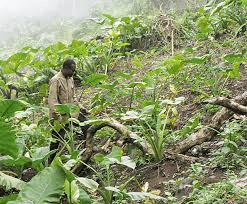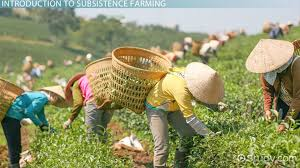Subsistence agriculture is a farming system where the main goal is to produce enough food to meet the needs of the farmer’s family. Unlike commercial farming, which focuses on generating surplus for sale, subsistence farming prioritizes self-sufficiency. This method has been fundamental to human survival for thousands of years, especially in rural and developing regions.
Historical Background and Evolution
1. Early Beginnings: Subsistence agriculture began when humans transitioned from hunting and gathering to farming, developing techniques to grow and cultivate crops and raise livestock to feed themselves.
2. Development of Farming Techniques: Early innovations included basic tools like plows and irrigation systems that improved crop yields and livestock management.
3. Modernization: Industrialization and modernization have brought challenges to traditional subsistence farming, leading to some shift towards commercial agriculture in many areas.
4. Current Trends: Despite modernization, subsistence farming remains prevalent in areas with limited access to advanced agricultural technologies. Efforts today focus on improving productivity and sustainability in subsistence practices.
Key Characteristics of Subsistence Farming
1. Focus on Self-Sufficiency: The primary goal is to grow enough food for the farmer’s household, with minimal surplus for sale.
2. Diverse Crops and Livestock: Farmers often grow a variety of crops and raise different types of livestock to ensure a balanced diet and mitigate risks.
3. Low Input Farming: Subsistence farming relies on natural processes and traditional practices rather than chemical inputs.
4. Labor-Intensive: Requires substantial manual labor, often provided by family members.
5. Small Scale: Typically involves small plots of land with farming practices tailored to local conditions.
Types of Subsistence Agriculture

1. Shifting Cultivation
a. Description: Also known as slash-and-burn agriculture, it involves clearing land by cutting and burning vegetation, then using the soil for a few years before moving on.
b. Benefits: Can restore soil fertility and maintain biodiversity if managed sustainably.
c. Challenges: Risk of deforestation, soil erosion, and reduced viability with increasing population pressure.
2. Intensive Subsistence Farming
a. Description: Involves using small plots of land to grow high yields of crops, often through methods like terracing and irrigation.
b. Benefits: Maximizes productivity on limited land, supporting high population densities.
c. Challenges: Can lead to soil depletion and requires significant labor and management skills.
3. Nomadic Herding
a. Description: Involves moving livestock from one grazing area to another in search of fresh pastures and water.
b. Benefits: Helps maintain ecological balance and reduces overgrazing.
c. Challenges: Faces issues like land rights conflicts, water scarcity, and integration with settled agricultural practices.
Read Also: The Techniques Used for Enhancing Farm Yield
Challenges and Limitations

1. Land Degradation: Intensive and shifting cultivation can lead to soil erosion, nutrient depletion, and loss of arable land.
2. Resource Limitations: Subsistence farmers often face limitations in resources such as modern tools, fertilizers, and pest control methods.
3. Economic Vulnerability: Limited access to markets and technology makes subsistence farmers vulnerable to economic fluctuations and environmental changes.
4. Population Pressure: Increasing population density puts additional strain on land and resources, leading to reduced fallow periods and lower soil fertility.
5. Climate Change: Variability in weather patterns and extreme weather events can impact crop yields and livestock health.
Impact on Local Communities and Ecosystems
1. Community Impact: Subsistence agriculture supports local communities by providing food security and maintaining traditional lifestyles. However, challenges like land degradation and economic instability can affect community well-being.
2. Ecosystem Impact: While traditional subsistence practices can be sustainable, certain methods like shifting cultivation may contribute to deforestation and habitat loss if not managed properly.
3. Cultural Preservation: Subsistence farming helps preserve cultural practices and knowledge passed down through generations, contributing to community identity and heritage.
Modern Adaptations and Practices
1. Sustainable Techniques: Adoption of sustainable practices such as agroforestry, conservation tillage, and organic farming can improve soil health and reduce environmental impact.
2. Technology Integration: Incorporating modern tools like improved seed varieties, water-efficient irrigation systems, and digital platforms for market access can enhance productivity.
3. Education and Training: Providing education and training on modern farming techniques and environmental management helps subsistence farmers adapt to changing conditions.
4. Community-Based Projects: Initiatives that support community-based resource management and cooperative farming can improve resilience and sustainability.
Read Also: 16 Medicinal Health Benefits Of Pomaderris kumeraho (Kumerahou)
Government Policies and Support

1. Agricultural Extension Services: Governments can provide extension services to offer training, technical support, and access to resources for subsistence farmers.
2. Subsidies and Financial Aid: Financial assistance, such as subsidies for inputs and low-interest loans, can help farmers improve productivity and manage risks.
3. Land Tenure Security: Ensuring secure land tenure and property rights is crucial for encouraging investment in sustainable farming practices.
4. Research and Development: Investing in agricultural research to develop resilient crops and efficient farming methods can support subsistence agriculture.
5. Infrastructure Development: Improving infrastructure such as roads, storage facilities, and market access enhances the ability of subsistence farmers to connect with broader markets.
Future Prospects and Sustainability
1. Enhanced Practices: Future prospects for subsistence agriculture involve integrating traditional knowledge with modern practices to improve productivity and sustainability.
2. Climate Adaptation: Developing and implementing strategies to adapt to climate change will be essential for maintaining food security and environmental health.
3. Supportive Policies: Continued support from governments and organizations can help address challenges and promote sustainable practices in subsistence farming.
4. Community Resilience: Strengthening community resilience through education, resource management, and cooperative efforts will be key to sustaining subsistence agriculture in the long term.
5. Global Collaboration: Collaborating with international organizations and engaging in global initiatives can provide valuable support and knowledge for improving subsistence farming practices.
Conclusion
Subsistence agriculture plays a crucial role in providing food security and supporting local communities, particularly in rural areas of developing countries. Understanding its historical evolution, key characteristics, types, and challenges helps appreciate its significance and impact.
Modern adaptations, government support, and sustainable practices are vital for overcoming challenges and ensuring the future viability of subsistence agriculture. By addressing these factors, we can support the continued resilience and sustainability of subsistence farming systems worldwide.
Read Also: Best Organic Fertilizer for Vegetables
Frequently Asked Questions
We will update this section soon.

